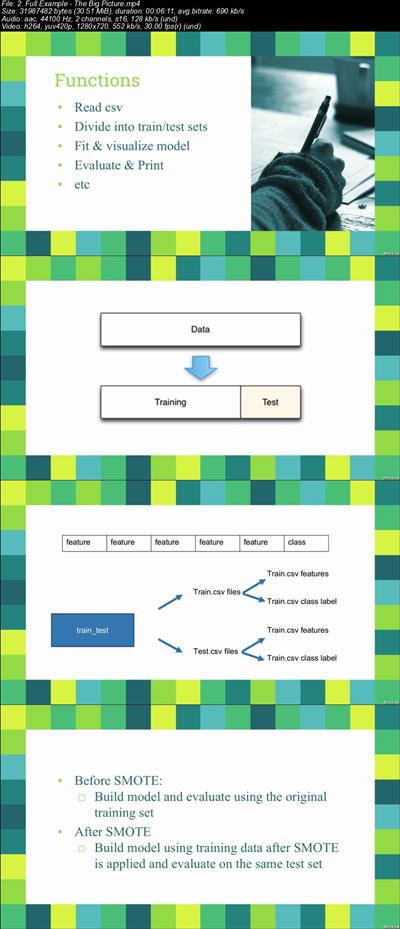Imbalanced Learning - The Complete Guide (Updated)
.MP4 | Video: 1280x720, 30 fps(r) | Audio: AAC, 44100 Hz, 2ch | 2.4 GB
Duration: 5 hours | Genre: eLearning Video | Language: English
Learn how to handle imbalanced data in Machine Learning. Data based approaches, algorithmic approaches and more!
What you'll learn
Understand the underline causes of the Class Imbalance problem
Why it is a major challenge in machine learning and data mining fields
Learn the different characteristics of imbalanced datasets
Learn the state-of-the-art techniques and algorithms
Understand variety of data based methods such as SMOTE, ADASYN, B-SMOTE and many more!
Apply Data-Based Techniques in practice
Understand different algorithmic approaches such as: One Class Learning, Cost Sensitive Learning and more!
Apply Algorithmic-Based methods in practice
Learn how to correctly evaluate a prediction model built using imbalanced data
Learn strategies and recommendations to help you avoid pitfalls when working with imbalanced dataset
Requirements
Prior knowledge in machine learning/data science is necessary or at least currently enrolled in a machine learning course.
Description
This is a niche topic for students interested in data science and machine learning fields. The classical data imbalance problem is recognized as one of the major problems in the field of data mining and machine learning. Imbalanced learning focuses on how an intelligent system can learn when it is provided with unbalanced data.
There is an unprecedented amount of data available. This has caused knowledge discovery to garner attention in recent years. However, many real-world datasets are imbalanced. Learning from unbalanced data poses major challenges and is recognized as needing significant attention.
The problem with unbalanced data is the performance of learning algorithms in the presence of underrepresented data and severely skewed class distributions. Models trained on imbalanced datasets strongly favor the majority class and largely ignore the minority class. Several approaches introduced to date present both data-based and algorithmic solutions.
The specific goals of this course are:
Help the students understand the underline causes of unbalanced data problem.
Go over the major state-of-the-art methods and techniques that you can use to deal with imbalanced learning.
Explain the advantages and drawback of different approaches and methods .
Discuss the major assessment metrics for imbalanced learning to help you correctly evaluate the effectiveness of your solution.
Who this course is for:
This course is for students and professionals who are working in the machine learning / data science area and want to increase their knowledge and skills. It is also for students who are currently taking a course in these areas. It is not for students with no background knowledge in Machine Learning.
Download link:Kod:rapidgator_net: https://rapidgator.net/file/763afb6134a13d6dc70a1d94aa0a5dd4/ga0cy.Imbalanced.Learning..The.Complete.Guide.Updated.part1.rar.html https://rapidgator.net/file/961b24c4ec2c342d6c6428be413548f7/ga0cy.Imbalanced.Learning..The.Complete.Guide.Updated.part2.rar.html https://rapidgator.net/file/af0cbfff0df134447eb596559697b7e3/ga0cy.Imbalanced.Learning..The.Complete.Guide.Updated.part3.rar.html nitroflare_com: https://nitroflare.com/view/38C3D74769B58EE/ga0cy.Imbalanced.Learning..The.Complete.Guide.Updated.part1.rar https://nitroflare.com/view/4D80EF64445ECA7/ga0cy.Imbalanced.Learning..The.Complete.Guide.Updated.part2.rar https://nitroflare.com/view/9D38C7427099C3F/ga0cy.Imbalanced.Learning..The.Complete.Guide.Updated.part3.rarLinks are Interchangeable - No Password - Single Extraction
1 sonuçtan 1 ile 1 arası
Hybrid View
-
15.10.2019 #1Üye



- Üyelik tarihi
- 20.08.2016
- Mesajlar
- 151.080
- Konular
- 0
- Bölümü
- Bilgisayar
- Cinsiyet
- Kadın
- Tecrübe Puanı
- 161
Imbalanced Learning - The Complete Guide (Updated)
Konu Bilgileri
Users Browsing this Thread
Şu an 1 kullanıcı var. (0 üye ve 1 konuk)



 LinkBack URL
LinkBack URL About LinkBacks
About LinkBacks






 Alıntı
Alıntı
Konuyu Favori Sayfanıza Ekleyin